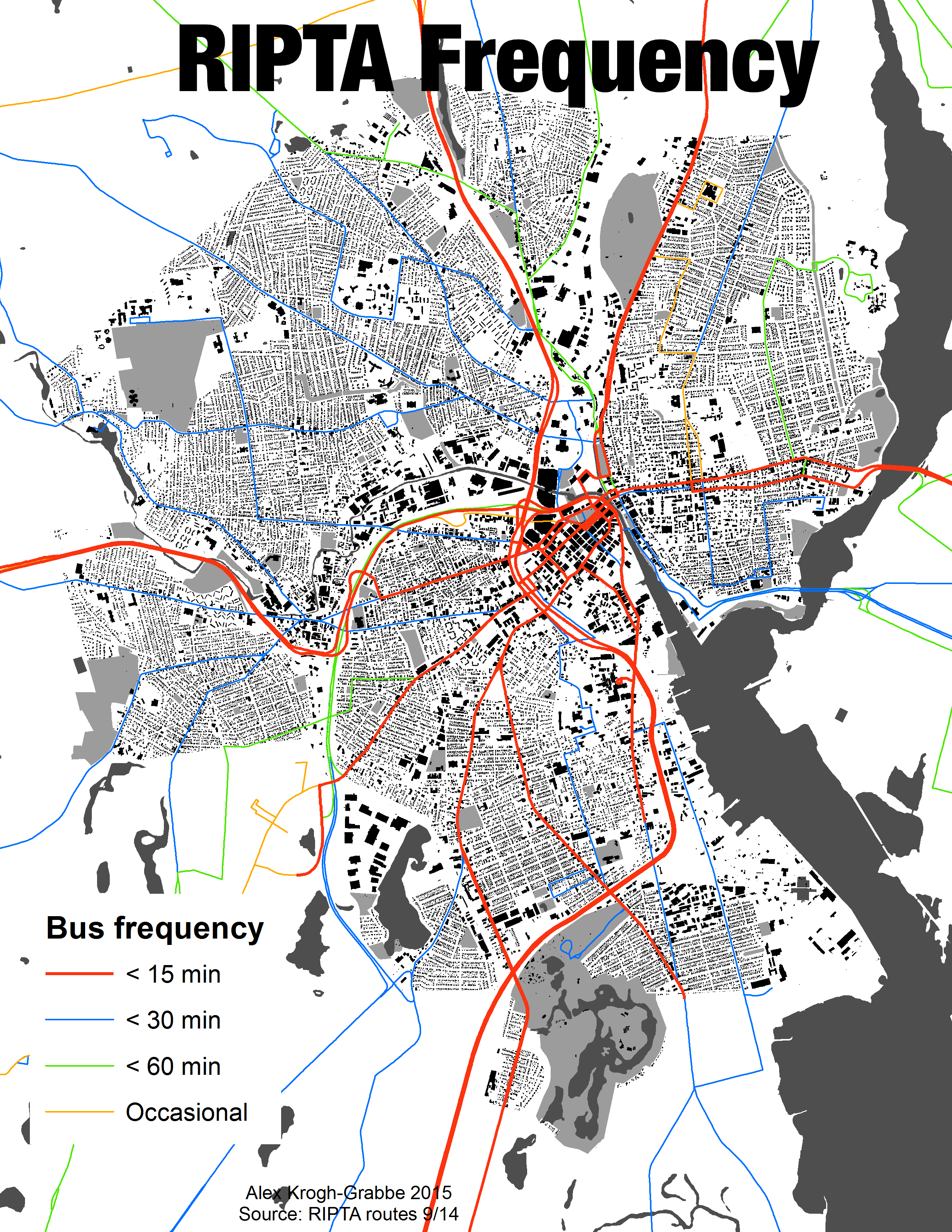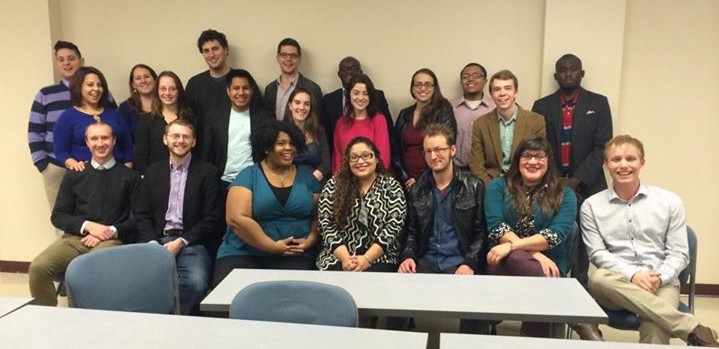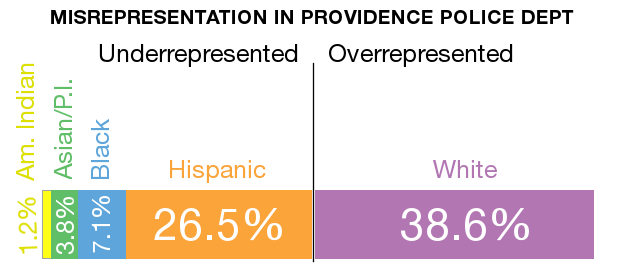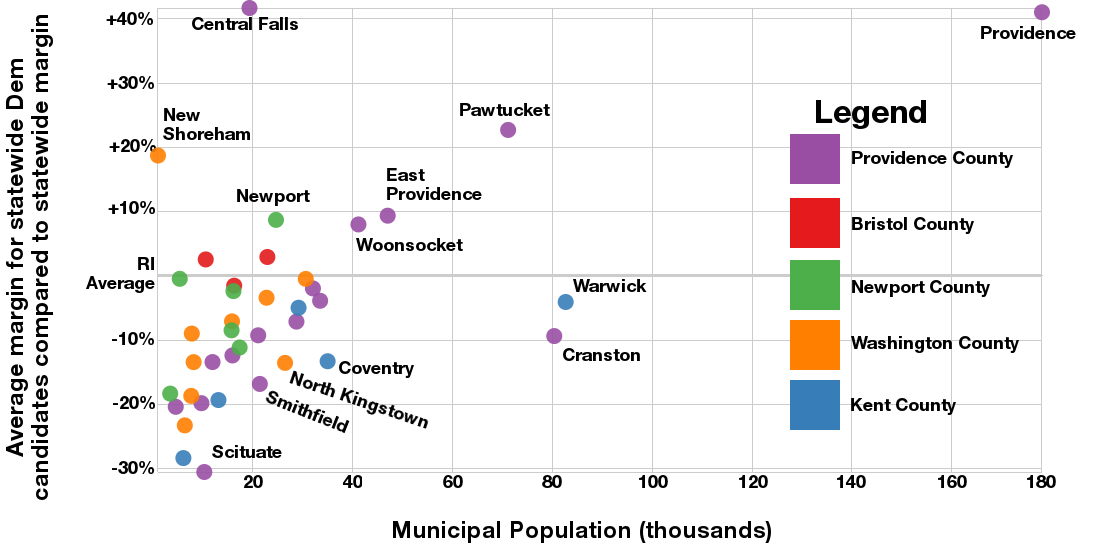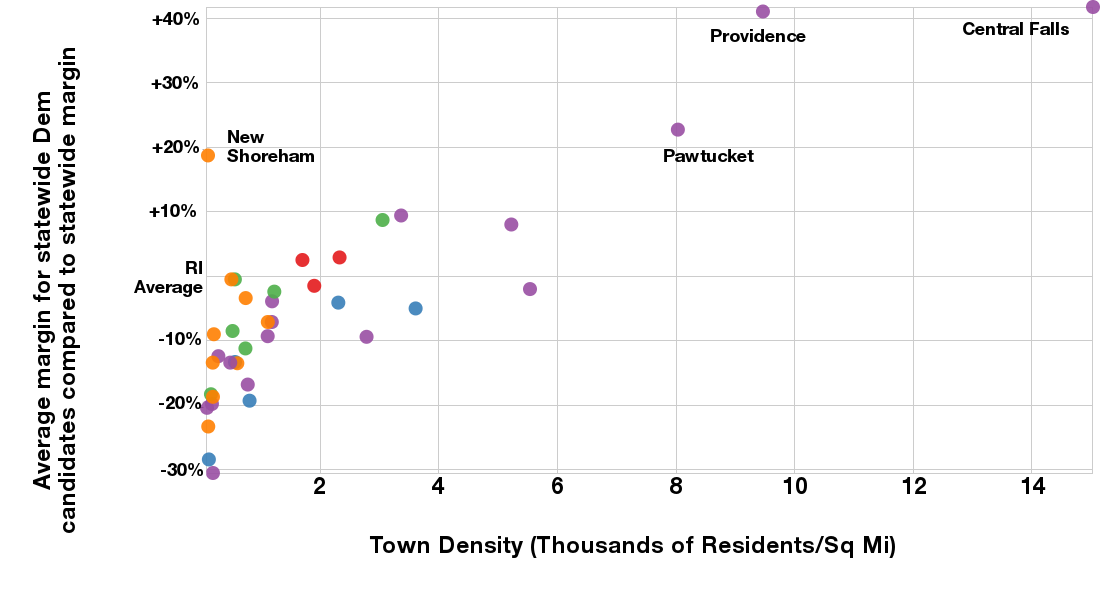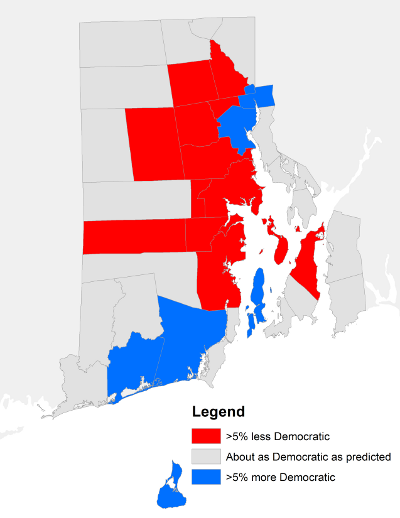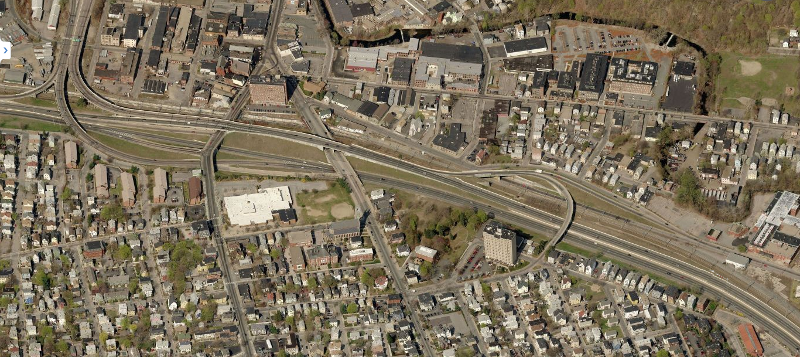
With Governor Raimondo’s recent push for transportation funding, people are talking about patching up the 6/10 Connector vs. replacing it with a boulevard. Best practice in urban design recommends replacing urban highways with boulevards. But that would be something we haven’t done before in Rhode Island, so it’s understandable that some people have concerns. Here are a few questions I thought you might have about updating the 6/10 Connector for the 21st century.
- That’s a big change. Wouldn’t it be expensive to remove the highway?Governor Raimondo is proposing a tractor-trailer toll that would allow the state to bond for $700 million. $400 million of that (plus another $400 million RIDOT wants to get from the Feds) is earmarked for the 6/10 Connector repairs. That is expensive.
Prices vary a lot for building highways, but urban highways with as many overpasses as the 6/10 Connector tend to be on the high end of the scale (and $800 million is quite high). Boulevards (think Memorial Boulevard in Providence, but more multimodal) tend to have a cost roughly ten times lower than an urban highway. Imagine how many structurally-deficient bridges we could make safe with an extra $360-720 million? That’s a very rough cost comparison, but what we can be sure of is that replacing the 6/10 Connector with a boulevard (even tripped out with the best complete streets features you can think of) would cost dramatically less than rebuilding it as a highway.
- So many cars use the connector! Wouldn’t removing it create massive traffic jams?Actually many cities have removed excessive urban highways and seen no marked increase in traffic. There are a couple reasons for this. Traffic is created through a process called “induced demand” where if you build more highways, drivers will use them. Conversely, if you eliminate an urban highway, fewer people will use it as a short-cut.
“But wait!” you say. “I use 6/10 as a shortcut! You want to reduce my transportation options!” Actually, in other cities that remove urban highways, they see the traffic that previously used the highway spread out over the city’s other streets. And there’s less potential for traffic jams when drivers have lots of options. It’s like how bugs congregate around lights on hot summer nights, but out in the dark it’s less buggy. 6/10 is the bug-clogged light, city streets are the cool night air.
And one more thing: our current transportation network overwhelmingly favors driving; it has big highways that cut swaths through neighborhoods that are uninviting to other ways of getting around. Leveling the playing field by making our street system more comfortable for more ways of getting around (RIPTA, walking, and biking as well as driving) gives you more choices and more freedom. Plus, it means more other people are choosing to walk or bike and they’re not clogging up the road in front of you.
- It’ll never happen. We can’t do innovative things in Rhode Island.I mean, this isn’t that innovative. And hey, we started the Industrial Revolution and moved rivers to revitalize downtown Providence. I think we have it in us to make a prudent economic decision to give Rhode Islanders more transportation options and safer bridges.
Plus, you cynics, politicians like ribbon-cuttings and ground-breakings. It’s not as sexy to photo-shoot the replacement of an archaic 1950s-era project as it is to pose for the first complete multi-modal corridor in the State.
We can assume that because the 6/10 Connector is in Raimondo’s investment plan, now is the time that something will happen with it. The state should choose the approach that is best for the neighborhoods adjacent to the corridor, which coincidentally is the option with the best return on investment. Replace the 6/10 Connector with an urban boulevard.
Want to help make this happen? Transport Providence is organizing a walk around the area in question today at 5:15 with Providence City Councilman Bryan Principe. The best thing you can do is to talk to people about this. Which people? Especially your representatives (state, federal, and city if you live in Providence), the Governor’s office, and RIDOT.
]]>But this is the 21st century.
In the 21st century, people don’t want to wait around in the cold for a bus, because they don’t have to. They have the internet, which can tell them, based on real-time location data, exactly when their bus is going to arrive. Or, maybe they live in an urban area that values its transit system enough to provide frequent enough service such that, even if you miss one bus, the next one will be along before your toes fall off from frostbite.
Unfortunately, neither of those things are true in Rhode Island.
Google Maps and other transit apps are still waiting for RIPTA to provide them with real-time data, instead of relying on scheduled bus arrival times. When you’re standing out at a stop in the cold, and you have a meeting you need to get to, what do you do with the statistic that a majority of buses arrive at each stop within 5 minutes of their scheduled time? Do you wait to see if the bus will come? Or do you walk over to the next transit corridor to maybe catch that bus? Or, more likely, you just don’t rely on the bus, because you don’t know whether it can get you there. When you can’t rely on the bus, it’s not a good alternative to car ownership for most people.
Or wait! Even if there’s some major technological, bureaucratic, budgetary, or other reason RIPTA can’t set up a process to format its data in the necessary fashion and provide a feed for Google and other apps (or even *gasp* citizen developers!) it doesn’t matter, right? There are a lot of bus lines; people can rely on the schedule and function pretty okay, yeah?
Except the problem is, RIPTA’s bus service is on the low end of frequency. Transit expert Jarrett Walker categorizes transit service based on off-peak frequency into four categories: buses every 15 minutes or less, every 30 minutes or less, every 60 minutes or less, and occasional service. If you miss those most frequent buses, no worries, because another will be along soon. If you miss the less frequent ones, you know the drill. Walk home, and tell that fantastic job or client you were really excited about that you won’t be able to make it.
So here’s a map of Providence with RIPTA routes colored according to frequency. Red is the best, then blue, then green, then orange is practically nonexistent service.
But look! There are lots of red lines there! Except if you notice, those red lines are mostly along limited-access highways, without much in the way of transit access to the people living next to them. I could count on one hand the corridors outside of downtown with actual frequent transit access:
- North Main (paragon of pedestrian friendliness that THAT is)
- West Broadway
- Cranston Street
- Broad
- Elmwood
- Waterman/Angell
- Eddy (only to Thurbers)
Okay I borrowed two fingers from the other hand. But THAT’S IT. No frequent service to RIC or PC. No frequent service to the Wards of City Council members Narducci, Ryan, Correia, Igliozzi, Hassett, or Matos, and hardly any to Councilman Zurier’s Ward 2 or Council President Aponte’s Ward 10. And really, the frequent coverage ain’t great in many other Wards; they just have one or two frequent lines running through them.
Ideally RIPTA would solve both of these problems, but of course there are budgetary constraints and an imperative to cover the whole service area with service. As Walker states in this awesome video (yes I’m a geek), there is a tension between the goal of coverage and the goal of frequency. And indeed, with the R-line and suggestions of further focus on the highest-potential routes, RIPTA is headed more in the direction of frequency than it has been historically.
But the other problem? C’mon RIPTA. We’re living in the 21st century. Get on it. Or tell us why you’re failing in this way. Do you think we don’t care? Or that you’ll look bad? We do care. You already look bad when you don’t tell us why you’re deficient in this area. Here are some links to help get you there if you’re not already on your way: GTFS-realtime. MBTA’s live-feed page. Transit Camp 2015 conference notes.
]]>On Saturday, the Young Democrats of Rhode Island held their annual convention at URI’s Feinstein campus in downtown Providence. Since 2010, YDRI has grown substantially, with over 100 active members in 2014. Participants hailed from a broad array of backgrounds, ranging from campaign staffers to concerned citizens, and from newly-elected legislators to progressive activists. Attendees were united by a shared commitment to improving Rhode Island’s government—especially for young people—and most of the day’s dialogue focused on actions that could be taken to enact those improvements.
The convention also featured a discussion on YDRI’s legislative priorities for 2015. Attendees split into three groups to identify and discuss young people’s most pressing legislative priorities. When the groups came back together and shared their priorities, there was significant overlap of issues between groups, focusing on economic equality, social justice, and environmental justice. Discussion repeatedly turned to issues of racial profiling, police relations, ending drug prohibition, and supporting economic growth for young Rhode Islanders via topics like college affordability. YDRI looks forward to continuing to build its membership base for action on these issues in 2015.
Over the coming months, the group will engage with partner organizations, with the goal of rallying advocacy efforts for those initiatives.
Speakers at Saturday’s annual meeting included:
- Outgoing YDRI President Mark Gray, who gave a compelling exit address regarding YDRI’s achievements and the priorities he would like to see the group approach in the future
- Constantina Meis, who, as Women’s Caucus Chair for the Young Democrats of America, updated YDRI on the efforts which the national YDA is currently undertaking regarding growing women’s and minority caucuses.
- Theo Groh, President of Young Democrats of New Hampshire, who shared updates on his work building chapters with the national YDA.
Theo also presided over YDRI’s elections for the 2015 Board of Directors. The new Board members are:
- President: Charon Rose
- Executive Vice President: Zack Mezera
- Vice President: Amy Espinal
- Treasurer: Jordan Day
- Secretary: Alex Krogh-Grabbe
- Communications Director: Michael Beauregard
- Membership Director: Abby Godino
- Policy Committee Chair: Juan Espinoza
- YDA National Committeeman: Chris Tallent
- YDA National Committeewoman: Kristina Fox
- Congressional District 1 Representative: Amanda Clarke
- Congressional District 2 Representative: Anthony DeRose
- At-Large Board Member: Representative-elect Aaron Regunberg
- At-Large Board Member: Senator Ryan Pearson
To learn more about the Young Democrats of Rhode Island, visit our website.
The Young Democrats of Rhode Island is the organization for young people 13-35 who wish to mobilize on behalf of the Democratic party and to advocate for issues facing young people in Rhode Island and America.
]]>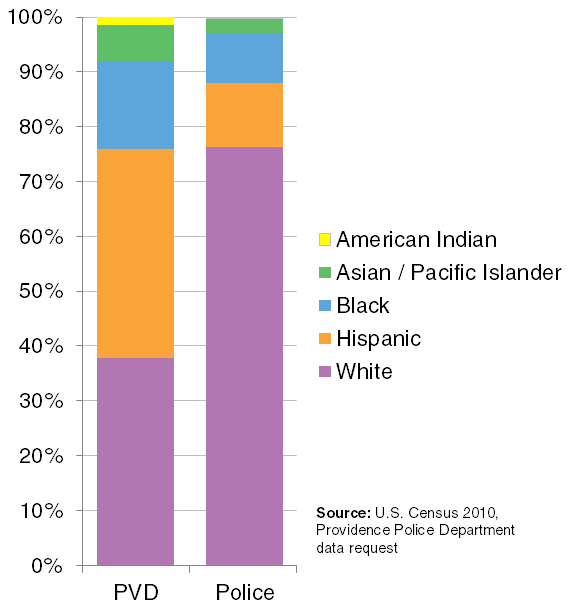 A lot of American cities have police departments that don’t proportionally represent the racial mix of residents. And Providence is one of the worst.
A lot of American cities have police departments that don’t proportionally represent the racial mix of residents. And Providence is one of the worst.
According to data provided by the office of the Public Safety Commissioner, the 444-officer Providence Police Department is 76.3 percent White, 11.7 percent Hispanic, 9.0 percent Black, 2.7 percent Asian or Pacific Islander, and 0.2 percent American Indian. According to the 2010 U.S. Census, the city as a whole is 37.8 percent White, 38.3 percent Hispanic, 16.1 percent Black, 6.5 percent Asian or Pacific Islander, and 1.4 percent American Indian.
That means the white portion of the PPD is 38.6 percentage points overrepresentative of the city as a whole, while the Hispanic portion is 26.5 percentage points underrepresentative, the black portion is 7.1 points underrepresentative, the Asian/P.I. portion is 3.8 points underrepresentative, and the American Indian portion is 1.2 points underrepresentative.
These numbers seem vaguely interesting without context, but in the context of other cities, they’re far more troublesome.
On October 1, data journalism blog FiveThirtyEight.com published an analysis of the 75 largest municipal police forces in the country. Providence has approximately the 90th-most officers in the country, so was not included in that analysis. The main thrust of that analysis was examining the effectiveness of residency requirements (tldr?: They actually correlate with worse representativeness). However, there is an excellent visualization putting all 75 departments side by side, ranked in order of how racially misrepresentative they are of their cities. I highly recommend checking it out.
So Providence wasn’t included in that analysis, and there are about 15 other departments that also weren’t included and have bigger departments than we do. But how do we compare to the 75 cities included in the analysis?
Only three of the cities FiveThirtyEight looked at have police departments worse at representing their communities than Providence. So that’s a problem.
In a statement, Providence Public Safety Commissioner Steven Paré said, “Recruiting a diverse workforce is always a priority. We hired two recruit classes for the PFD and one recruit class for the PPD. It was one of the most diverse classes we’ve had in our history. Our goal is to mirror the community we serve. The challenge is to reach out to the available workforce in the region and recruit the best candidates.”
The new class of 53 police officers was the most diverse in 20 years, with 9 Hispanic recruits and 13 other minorities. But the class itself overrepresented white Providence by 20%, and barely budged the underrepresentation of Latinos.
When it comes to recruiting new and diverse officers, Paré said he’s “battl[ing] the perception that you need to have a connection to become a police officer,” he said. “It exists in the profession.” He acknowledged the fire department “can do a better job…recruiting more women. It is always difficult to get women interested in the fire services because of the physical demands that is required.” (What, because women have trouble doing physical work? *facepalm*)
Importantly, Paré welcomes ideas from the community. “We have invited community stakeholders to become part of the process for their input, ideas and recommendations to improve how we hire police and fire,” he said. “They have been critical partners in these last 3 training academies.”
There’s racial misrepresentation to address in Providence Public Safety, but with willing leadership and the active participation of community groups, maybe we can solve the problem together.
]]>Will focuses on General Assembly and Town Council races, but his post made me wonder how different towns around Rhode Island voted compared to the state averages. So I dug into the numbers for statewide races. Here’s what I came up with:
Democratic Lean by Town Population
Democratic Lean by Town Density
This is a little confusing; here’s what I did:
- I looked up what percentage of the votes in each town the Democrats and Republicans for each statewide office received.
- I subtracted the GOP candidate’s percentage from the Democrat’s for each town, giving the percentage margin the Democrats won (or didn’t) by.
- I then averaged together the margins for each statewide race, roughly giving each town’s Democratic lean.
- I then subtracted the average statewide Democratic lean from each of those town leans, giving us an idea of how each town compares to Rhode Island as a whole.
Those are the numbers you see above. Here’s my spreadsheet. A few observations:
- Hardly anyone lives in New Shoreham. But we already knew Block Island isn’t a population hub. (These population numbers are from Wikipedia and could be wrong.)
- There’s a clear trend of the denser and more populous cities voting more for Democrats than less populous towns. I ran the correlations and it’s 0.55 for population and 0.82 for density. Both are reasonably strong.
- Imagine the vaguely logarithmic trendline that would best fit these points. For the density graph the formula for that trendline would be
y = 0.084*ln(x) - 0.6147. It’s in relation to that trendline that I’ve made the map at right. Gray towns are those that voted about how you’d expect based on their density, blue towns voted more Democratic than density would suggest while red towns voted less Democratic. - Remember this is one point in time, November 4, 2014. It can’t tell us a lot about how things are changing or how all those people who didn’t turn out would vote if they did.
So at the end of the day, what does this tell us? Municipalities with higher population & density tend to vote for Democrats more than towns with lower populations. This isn’t just true in Rhode Island, it’s true across the country. But what is interesting here is how different areas of the state deviate from that implied trendline.
]]>